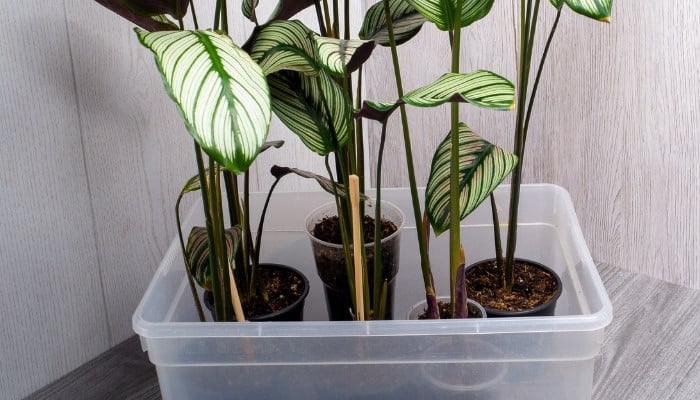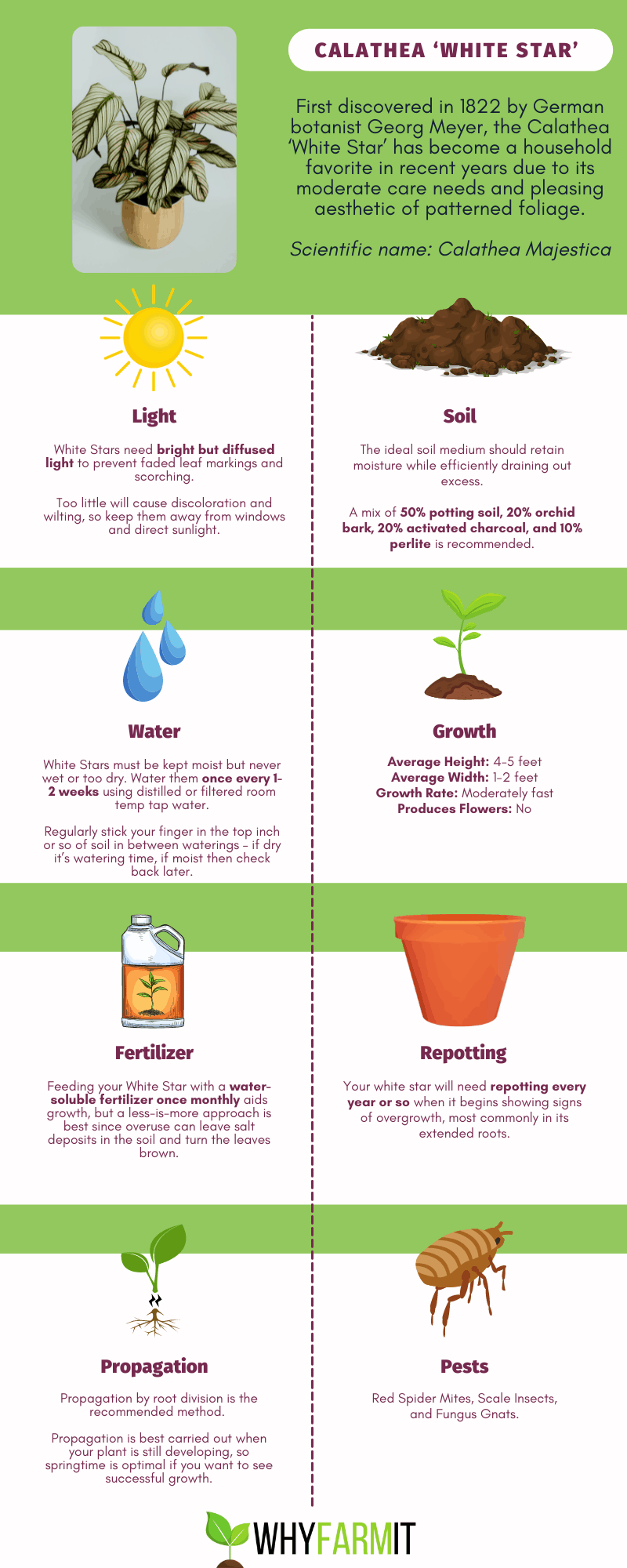The exotic Calathea ‘White Star’ is both a quaint office staple reminiscent of times past, and a modern addition to home décor, making it beloved to every plant enthusiast.
Its contrasting white and green foliage with violet undersides and subtle pink blush make a style statement, but it takes dedication to look this good.
How do you care for Calathea ‘White Star’? Calathea White Stars require conditions similar to that of their native tropical environment. They need nutrient-rich, moist, lightweight soil that drains well, indirect sunlight, weekly watering, 60-70% humidity, room temperature between 65-77°F, and monthly fertilization to thrive.
Caring for Calathea White Star: Basic Guidelines
Calathea White Stars are not beginner-friendly plants, but don’t be discouraged by the specific care needs required as the rewards of keeping them are plain to see with a little effort.
From the ideal soil and repotting process to pro tips and FAQs, we’ve left no leaf unturned in this guide to caring for your Calathea ‘White Star’.
Complete Care Guide for Calathea White Star
First discovered in 1822 by German botanist Georg Meyer, the Calathea ‘White Star’ has become a household favorite in recent years due to its moderate care needs and pleasing aesthetic of patterned foliage.
Its durable, waxy leaves were historically used to make baskets and transport fish and rice – a method still used in parts of South America today.
Calathea White Star at a Glance
- Plant Type: Tropical evergreen
- Scientific Name: Goeppertia majestica
- Average Height: 4-5 feet
- Average Width: 1-2 feet
- Growth Rate: Moderately fast
- Produces Flowers: No
- Common Pests: Spider mites, mealy bugs, leaf scales
- Life Expectancy: 8-12 months (many years with proper care)
- Difficulty of Care: Medium
What To Do When You First Get Your Calathea White Star
- Check the soil and both sides of the leaves for pests. It’s wise to keep your White Star in a separate spot for the first week to protect any nearby plants.
- Feel the top 2 inches of soil for moisture, and water it if it feels dry.
- Keep your White Star in the pot it arrived in for the first week as re-homing too quickly can cause stress and impede growth.
Ideal Soil for Calathea White Star
The ideal soil medium should retain moisture while efficiently draining out excess.
Biologist and author of the Indoor Garden Nook blog Sara E. Taylor recommends the following mix:
- 50% potting soil – basic garden-store variety is fine, or choose “peat-free soil made with coconut husk fibers for improved drainage.”
- 20% orchid bark – “this helps absorb excess water and releases moisture back into the soil as the mix becomes dry”
- 20% activated charcoal – this fine powder helps prevent root rot, repels pests, and removes impurities that contribute to mold.
- 10% perlite – these are lightweight pH-neutral granules that aid drainage and improve soil aeration.
Calathea White Star Water Requirements
White Stars must be kept moist but never wet or too dry. Water them once every 1-2 weeks using distilled or filtered room temp tap water.
Regularly stick your finger in the top inch or so of soil in between waterings – if dry it’s watering time, if moist then check back later.
Taylor suggests repeating this until you “determine your watering timetable” since watering hinges on so many variables including plant size, season, and household conditions.
Calathea White Star Lighting Needs
To recreate the filtered sunlight of the rain forest canopies, White Stars need bright but diffused light to prevent faded leaf markings and scorching.
Too little will cause discoloration and wilting, so keep them away from windows and direct sunlight.
Ideal Temperature Range for Calathea White Star
Temperatures between 65-77°F (18-25°C ) are recommended.
While resilient, long exposure to temperatures below 65°F can risk slow growth and even complete dormancy (when growth halts and they conserve energy, similar to hibernation), so be sure to keep them away from drafty rooms.
Ideal Humidity Level for Calathea White Star
White stars will thrive in humidity levels of 50-60%. Leaves with brown edging let you know the humidity is too low.
Misting the leaves 1-2 times per week will replicate the moisture of the tropics.
You can further manage levels with a hygrometer for monitoring humidity (I’ve found this one to be accurate and reliable) and a humidifier.
Best Location for Calathea White Star
This plant loves low-light, humid environments, so placing them in or near your bathroom is a good spot.
Many Calathea owners also advocate placing them in the kitchen or bedroom so long as the right conditions are maintained.
Calathea White Star Growth Habits
Growth habit refers to the shape, height, and life form of a plant.
A Calathea ‘White Star’ has a shrub-like form, meaning its stems grow upright and tall in their pot as opposed to draping over like ferns or climbing like vines.
Fertilization Type & Schedule for Calathea White Star
Feeding your White Star with a water-soluble fertilizer once monthly aids growth, but a less-is-more approach is best since overuse can leave salt deposits in the soil and turn the leaves brown.
Take care to dilute fertilizer solution strength by half.
Signs of Nutrient Deficiency
Leaf discoloration (yellowing) and distortion (curling, drooping) are typical signs that a White Star is lacking nutrients.
If the plant is under watered or the soil medium is not appropriate (i.e. too alkaline or acidic/low porosity), then nutrients cannot adequately transport to the roots, causing leaves to change shape and color.
Pruning Calathea White Star
White Stars are not particularly bushy and rarely grow beyond 5 feet, so they will not require regular pruning.
Be sure, however, to remove dead/diseased leaves (tips on identifying and preventing this later) by gently “pinching” the leaf or carefully cutting the affected area at the stem with clean scissors.
Does Calathea White Star Produce Flowers?
White Stars don’t flower when kept indoors and are most commonly grown for their patterned foliage.
If you’d prefer a flowering Calathea, gardening expert of 25+ years Karen Travis recommends the Calathea crocacta, which produces bright orange flowers, though warns they are higher maintenance and “produce very plain foliage.”
Is Calathea White Star Toxic?
White Stars are nontoxic to humans and pets, with the ASPCA (American Society for the Prevention of Cruelty to Animals) declaring them nontoxic to cats, dogs, and horses.
Calathea White Star Propagation

To control growth or multiply your collection, you may choose to propagate (growing new plants from cuttings and divided roots) your White Star.
Since the stem tissue of Calatheas cannot adequately support new growth, biologist Sara E. Taylor recommends “propagation by root division, not cutting” as the best method.
1. Prepare New Separate Pots for Quick Planting
Speed is important to conserve as much moisture as possible when dividing and planting each root structure, so make sure you have your new plastic pots (with drainage holes in them) close by and filled with the same potting soil medium as the parent plant for quick, efficient planting.
2. Remove the Parent Plant From Pot To Expose the Roots
Placing the bare soil upright on some newspaper or in a large bag, carefully loosen the soil structure by hand, taking away chunks to expose the roots.
This may be tougher depending on the soil mix and plant size, so you can also use a knife to carefully slice into the soil to separate stem clusters.
3. Carefully Unwind Tangled Stems & Separate Root Bulbs
Gently unwind any tangled stems by hand and divide stem clusters or pairs ready for re-planting.
Stem clusters will be connected to root bulbs that form a small part of the overall root crown, so take care when detangling or cutting through the soil not to damage these bulbs.
4. Plant the Separated Stem Pairs/Clusters Into Pots
Begin planting your separated stem groupings into their new pots, and water each one to allow the roots to take in the nutrients immediately.
Place each in a room with indirect sunlight, and return the original parent plant to its pot, filled with the same level of soil prior to being removed.
5. Only Propagate Your Calathea Plant in Spring
Propagation is best carried out when your plant is still developing, so springtime is optimal if you want to see successful growth.
Attempting to propagate in colder seasons can disrupt and “shock” your Calathea plant since it will not respond well to being moved at this time.
Repotting Calathea White Star
Calathea White Stars are quite fast-growing plants and will need to be repotted over time to accommodate their growing width and height.
When To Repot Calathea White Star
Your white star will need repotting every year or so when it begins showing signs of overgrowth, most commonly in its extended roots.
It may also need repotting due to a need for new soil if the current mix is stunting growth.
When roots begin poking out of the drainage holes in the inner pot, plants can be at risk of becoming root-bound, when the roots begin to take up the entire space within the pot.
Signs That It’s Time To Repot
- Roots are visibly overgrown at the base and within the soil
- Stunted foliage growth
- Droopy, yellowing foliage even when soil is moist
How To Repot Calathea White Star
1. Choose the Right Container for the Repotting Purpose
Based on the above signs, you’ll either want to pick a larger pot to accommodate growth (at least 2 cm larger than the current one) or else repot into the existing pot if the soil needs changing, in which case the current pot should be washed and disinfected.
2. Water the Day Before Repotting For Easy Removal
This will make the soil soft and easier to remove from the pot. When it’s time, gently pull the plant out of its pot and brush off excess soil.
3. Inspect the Roots for Signs of Disease
Examine the overgrown roots for signs of disease like root rot (black and mushy).
Healthy roots can be black or pale but should be firm to the touch. Remove any diseased sections and consider using fungicide to prevent disease spreading in the new pot.
4. Fill the New Pot 1/3 Full Before Re-planting
Fill your new pot up to a third of the way with your potting soil mix, and pat it down before placing the plant back in.
Fill the rest of the pot, and press firmly on the soil to ensure it is well stabilized.
Place your newly repotted White Star in the same location and anticipate growth resuming after a week or so due to shock.
Calathea White Star Common Problems & Solutions That Work
Calathea White Star Common Pests
Even the most vigilant plant owner occasionally discovers pests, but if you can recognize the signs, quick action can prevent your White Star from suffering any serious damage.
Veteran plant-owner and chief contributor at OurHousePlants.com Tom Knight shares the symptoms and solutions in dealing with common critters:
Red Spider Mite
- Signs of Trouble – Sticky webbing and mottled, brown spots on foliage.
- Solution – Give your plant a tepid weekly shower to wash away webbing and reduce numbers.
- Prevention – Remove dust from leaves once weekly with a damp cloth. Mist regularly to maintain humidity, and consider purchasing a predatory mite (Phytosieulus persimilis).
Scale Insect
- Signs of Trouble – Rice-shaped brown discs on the stems or underside of leaves. Sticky honeydew near and around the plant.
- Solution – Pick off or dab individual scales with a cotton swab of alcohol to dissolve them.
- Prevention – Spraying the leaves with organic neem oil (I’ve had great success with this neem from Amazon) acts as a pesticide as the oils clog their breathing pores.
Fungus Gnat
- Signs of Trouble – Small fruit fly-type insects in the soil, sudden wilting, and slow growth
- Solution – Dispose of the top soil layer outdoors, and replace with a dry top layer as they love moist conditions.
- Prevention – Introduce nematodes in the soil. These microscopic worms seek out the larvae stage of gnats, which can help break the cycle.
Calathea White Star Common Diseases
Meeting your White Star’s basic needs can give it a fighting chance when to comes to diseases, but you’re only human, so if and when the following does occur, here’s what to look for and how to tackle it:
- Basal Stem Rot
- Signs of Trouble – Slow growth, discolored foliage, swollen mushy stems.
- Solution – Prune diseased stems and repot healthy stems in fresh soil and a sterile pot.
- Prevention – Allow the top soil to dry in between watering and use a soil medium with good drainage quality by adding bark chips and perlite to open up the soil.
Rust fungus
- Signs of Trouble – Small brown spots or rings on the leaf undersides.
- Solution – Prune badly affected foliage and use a fungicide spray containing Flutriafol on nearby leaves.
- Prevention – Space plants evenly apart to encourage air circulation. Avoid wetting the foliage when watering.
Nutrient Deficiency
- Signs of Trouble – Poor growth, curling, yellowing, or dulled leaves.
- Solution – Repot in fresh soil mix or apply a liquid fertilizer to the foliage.
- Prevention – Keep the plant well hydrated, repot when needed, and use the recommended soil mix. Horticulture educator Marie Iannotti also recommends “performing a pH soil test periodically to correct nutrient imbalances before they worsen.”
Other Common Problems
When a pest infestation or disease isn’t the culprit, poor care and environmental factors can cause problems for your White Star.
This is usually evident in the shape, color, and form of the foliage:
Yellowing Leaves
- Signs of Trouble – Yellow, light-brown leaf tips.
- Solution – For minimal discoloration, trim the affected leaves and remove affected stems for excessive yellowing.
- Prevention – At best this is down to overwatering and overly moist soil, so use a well-draining soil medium and let the top soil layer dry between watering. Failure to act quickly could result in root rot.
Wilting or Drooping Leaves
- Signs of Trouble – Limp, lackluster-looking foliage
- Solution – Feel the top two inches of soil to see if it needs watering or if it has been overwatered and needs a longer drying period.
- Prevention – Monitor humidity and temperature levels regularly. Reconsider the plant’s location if it has become too cold or drafty.
Faded Leaves
- Signs of Trouble – Bleached, sun-scorched leaves or faded pattern.
- Solution – Move your plant to a shadier location, and gradually acclimatize it to a spot with greater sunlight. If it has remained in the same soil for close to a year, consider changing.
- Prevention – Keep your White Star away from bright, direct light, and try using fertilizer once per month to encourage growth in spring and summer.
Calathea White Star Common Questions

Are Calathea White Stars Rare?
Calathea ‘White Star’ is one of the rarer varieties in the Calathea plant genus due to its desirable, decorative foliage of vibrant white-and-green stripes and subtle pink blush in between the leaf veining.
Do Calathea White Stars Like Bottom Watering?
Bottom watering is not recommended regularly as excessive moisture can lead to root rot.
This watering method is sometimes necessary to remove large-scale pest infestations in the soil, so long as the top inch of soil remains dry.
How Do You Revive a Calathea White Star?
Restore a discolored or misshapen plant by removing damaged foliage and repotting the remaining healthy stems in a clean, disinfected pot with fresh soil mix.
You can also add some diluted houseplant fertilizer once a month for a new lease on life.
Why Is My Calathea White Star Curling?
This can be due to over or underwatering, so adjust your watering schedule accordingly and check to see if the leaves uncurl themselves.
If curling persists, it could be a stress response to recently being moved or a drop in temperature.
How Do You Stop Calathea White Star Drooping?
White Stars naturally droop ever so slightly during the day.
However, consistent drooping is linked to thirst, so stay on top of your watering regimen and poke the soil with a chopstick/dowel to ensure water reaches the roots.
What Is the Price of a Calathea White Star?
For a Calathea ‘White Star’, costs vary across plant retailers and will depend on the White Star’s size and maturity. Prices typically range between $20-$70.
Why Is My Calathea White Star Turning Yellow?
Yellowing foliage can have many causes, such as excessive sun exposure, overwatering, or stress from recently being repotted.
If your White Star is new, slight yellowing on the lower leaves is common as nutrients are reabsorbed as it grows.
Why Does My Calathea White Star Have Brown Spots?
Brown spotting can be a sign of plant rust from too much light but could equally be a sign of over or underwatering, so be sure to aerate the soil occasionally with a chopstick.
Brown dots may also be a symptom of red spider mites as they pierce the leaf cells and leave behind mottled brown specks.
Why Is My Calathea White Star Dying?
Calathea struggle when indoor conditions don’t adequately match the humidity, temperature, and moisture of their natural habitat.
If you are doing all you can to monitor these levels as discussed, an unobserved pest infestation or root disease could be causing deterioration.
Is Calathea White Star a Prayer Plant?
Yes, White Stars are part of the “prayer-plant” family due to their leaves folding inwards at night.
Keeping them in the bedroom allows plant owners to enjoy the unfurling and closing of the leaves as the sun rises and sets each day.
Calathea White Star vs. Pinstripe (Ornata)
Calathea ‘Pinstripe’ plants feature thinner, more spaced-out white striping compared with White Stars, and Pinstripes have more noticeable pink overtones on their leaves.
They share many similarities: need moisture-retaining soil with good drainage, nontoxicity, and susceptibility to many of the same pests.
Calathea White Star vs. Vittata
Calathea ‘Vitatta’ plants share the wide, bold, striped foliage of White Stars, though these are much smaller Calathea (reaching maximum heights of 1.9 feet) and so must be placed in a higher location to reach indirect sunlight.
They also sport green undersides to their leaves as opposed to the purple coloring on White Stars.
Calathea White Star vs. Calathea Fusion
The Calathea ‘Fusion’ sports stunningly variegated foliage, with marbled green-and-white leaves that create a delicate watercolor effect.
Though they share much the same moisture, humidity, and watering needs, Fusions can cope equally well in acidic or pH-neutral soil.
3 Key Tips for Success With Calathea White Star
1. Use Organic Care Methods (Where Possible)
Organic alternatives to store-bought fertilizer, pesticide, mister, and potting soil can result in a healthier, longer-lasting plant, and needn’t break the bank as many homemade recipes can be sourced online.
Organic soil in particular is rich in nutrients and minerals that aid your plant’s resistance to disease by strengthening cell walls.
2. Invest in a Humidifier & Hygrometer (Humidity Monitor)
Caring for White Stars can be a balancing act, but taking the guesswork out with a humidifier and monitor can help your plant grow in its ideal conditions – leaving you to work out your watering timetable and stay on top of other areas, such as pest control and disease prevention.
Pro Tip! If you build up a collection of Calathea (any type), group them together to maintain the correct humidity levels.
3. Get “In Tune” With its Watering Needs
From root to tip, many of the White Star’s health issues hinge on whether it has been under or overwatered, so as silly as it sounds, spend your first 6-8 weeks getting to know its water preferences.
Biologist Sara E. Taylor calls it “asking” her plant with a finger in the soil every other day for a moist or dry “response.”
Conclusion
To summarize, Calathea White Stars are stunning mid-maintenance plants that thrive in homes that can simulate the humidity and diffused sunlight of tropical South America.
Once you establish a good care routine with your White Star, these plants can become a long-term commitment and joy so long as you refresh their soil, repot them as they grow, and keep pests and disease under control.

Sources:
https://mylittlejungle.com/calathea-white-star/
https://pointlessplants.com/blogs/plant-care-guides/iggy-the-calathea-majestic-whitestar
https://www.youtube.com/watch?v=m1Gpuua4NXs
https://www.ukhouseplants.com/plants/calathea-goeppertia
https://gardengoodsdirect.com/products/calathea-white-star-plants
https://indoorgardenook.com/calathea-guide/#3
https://www.apartmenttherapy.com/how-to-care-for-calathea-32097893
https://houseplantcentral.com/problems-with-calathea/
https://www.stodels.com/step-step-guide-to-plant-propagation/
https://www.wildinteriors.com/blog/how-to-propagate-plants-a-beginners-guide
https://smartgardenguide.com/how-to-care-for-calathea-ornata/

